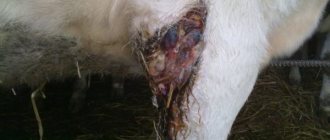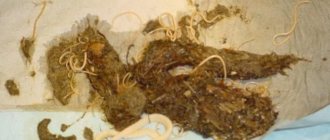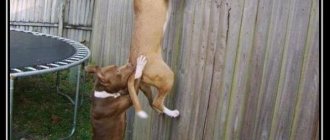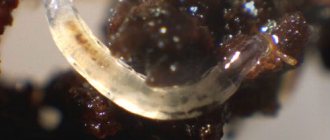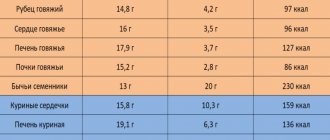Worms are parasitic worms that live, feed and reproduce in the donor's body. They enter the digestive tract, spread throughout the organs and do not manifest themselves for years. But all this time, great harm is done to the dog’s health. And communication with a pet can cause infection to humans and other pets.
Symptoms
Helminthiasis in dogs is sometimes asymptomatic or disguised as other diseases. But attentive owners can determine the presence of worms by the following signs:
- Developmental delay. Puppies grow poorly and are inactive. They have matte fur and a bluish rim to the whites of their eyes.
- Weight loss. With normal or increased appetite, the pet looks exhausted. His ribs stand out, but a hard, swollen belly can be felt.
- Eating disorders. Balls of worms prevent food from moving through the intestines. Sometimes after eating, hiccups, diarrhea, vomiting, and stomach rumbling appear.
- Impurities in feces. Pus, mucus, blood, parasites, larvae, and eggs are visible in vomit and feces. When attached to the anus, worms cause itching and a desire to scratch the butt on the floor.
- Breathing problems. A dog with lungworms or heartworms is breathing and coughing frequently. She is tormented by tachycardia and heart pain. The animal hides in a corner and refuses food.
Helminths absorb nutrients necessary for the dog's life. A deficiency of beneficial components is manifested by hair loss and changes in the color of the mucous membranes. The dog becomes lethargic, weak, and quickly gets tired on walks.
How to remove worms at home
Signs of helminths in dogs may coincide with symptoms of other diseases, so consultation with a veterinarian is always necessary to establish an accurate diagnosis. In rare cases, surgery or treatment under the supervision of a gastroenterologist may be required, but most often the problem can be solved by taking medications at home.
When treating, it is important to also treat the dog’s sleeping area and other places and rooms where there may be parasite eggs. If there are several pets living in your home, all should be treated at the same time, even if signs are found in only one.
Types of helminths
Only a veterinarian can determine the type of worms in a puppy or dog. A diagnostic examination will allow you to find out what parasites live in your pet’s body.
Nematodes or roundworms
Roundworms are often found in dogs that pick up food on the ground or drink water from a puddle. Roundworms, pinworms and other nematodes have a thread-like shape with a round cross-section. Most often they are fixed in the gastrointestinal tract, but they can also parasitize in other organs of the animal.
Trematodes or flukes
Flatworms appear in a dog’s body after eating raw fish and seafood or drinking dirty water. The worms are leaf-shaped and have suckers for attachment to the walls of the organ. They parasitize in the intestines, liver, and bile ducts. Infection with trematodes can cause the development of liver cirrhosis, pancreatitis, and jaundice.
Cestodes or tapeworms
Tapeworms appear in dogs after accidentally ingesting fleas or other skin bloodsuckers. It is ectoparasites that are carriers of cestode larvae. Helminths grow and multiply in the intestines, attaching to its walls with suction cups. As a result, the gastrointestinal tract becomes clogged with worms, causing intoxication and exhaustion.
Intestinal
White, yellow and gray worms in a dog can live in various organs. Sometimes they travel through the circulatory system. But most often, parasites colonize the dog’s intestinal tract. There they can easily obtain nutrients for their development and growth. Without treatment, they clump into balls, causing obstruction in the intestines.
Pulmonary
All lungworms in puppies and dogs have a common developmental feature. The larvae of these helminths pierce the intestinal walls, enter the bloodstream and migrate through it until they enter the capillaries of the bronchi or alveoli. Oxygen activates their development and growth. Reaching 3–4 mm in length, they exit into the oral cavity with a cough, and then are swallowed again and enter the intestines.
Heartfelt
Heartworm and Dirofilaria immitis roundworms are heart parasites. They enter the pet's body through an insect bite in the form of larvae. Then they migrate through the circulatory system, staying in the ventricles of the heart, eyes, peritoneal tissues, and under the skin. Without treatment, heartworms or subcutaneous worms can cause death in dogs. Small ornamental breeds are especially sensitive to their effects.
Roundworms in dogs
Worms with an elongated, non-segmented body, round in cross-section, that infect the intestines of an animal. Nematodes are parasites that most commonly form from within an animal's intestinal tract, but the most dangerous varieties shock the heart. They are usually snow-white or pale chestnut in color, a couple of centimeters long. The testicles of roundworms enter the environment together with feces and become infectious after ten days.
The most common cases of infection are two types of parasites: Toxocara canis (T. canis) and Toxascaris leonina. Dogs become infected with these types of roundworms by ingesting eggs from a contaminated environment. Toxascaris leonina differs from Canis in that the larvae do not migrate outside the intestine.
Roundworms can also be passed from mother to puppy through milk. According to research, if there are a couple of larvae in the mother’s body, then in puppies they move into the mammary glands and enter the body. Within a couple of months after infection, the dog begins to show signs of the presence of roundworms.
Toxocariasis in a dog shows signs:
- Slow, however, increasing exhaustion under circumstances where the dog is provided with adequate nutrition. The impression is formed that everything that the creature absorbs is wasted;
- The coat loses its shine, becomes pale and unclean. In animals with long hair, strands and curls do not form, and shedding increases and lasts constantly;
- Diarrhea may alternate with constipation;
- In some cases, single parasites or whole glomeruli are observed in feces;
- The dog behaves inappropriately, whines, barks, does not find a place for itself;
- Vomiting is common in puppies under 6 months of age. In some cases, yellowing of the visible mucous layers is possible;
- During the movement of Toxocara larvae through the lungs, paroxysmal coughing can be observed. Sometimes foam may appear;
- Strong anxiety when trying to palpate the intestinal tract;
- When examining blood in dogs, during the acute phase of toxocariasis, one can notice the appearance of a significant number of young leukocytes and an increased number of eosinophils;
- In addition, puppies may exhibit allergic interactions, expressed to a greater extent in the variant of atopic dermatitis.
To prevent the disease from reaching an advanced stage (especially dangerous for a puppy), it is necessary to contact a veterinarian at the first signs of concern and have the animal diagnosed.
Routes of infection
Helminths enter the animal's body in various ways.
- From mother. A pregnant dog with round flatworms or tapeworms passes the larvae to the puppy during pregnancy.
- Through ectoparasites. Ticks, fleas and other bloodsuckers infect your pet when they bite. The dog can also accidentally swallow an insect.
- Through raw meat and fish. Without heat treatment or freezing, the eggs and larvae of worms remain viable in muscle tissue for a long time.
- Through the mud. Worm eggs are released in feces and remain in the soil, sand, garbage, and dirty water.
Pets who do not leave the apartment due to illness or young age can also become infected. Helminth eggs enter the house on the soles of the owner's outdoor shoes.
Treatment
The first treatment of puppies for any type of worms should be carried out at the age of three weeks. Babies, pregnant and lactating bitches, and elderly pets are extremely sensitive to toxins that are released after the parasites die. Therefore, to treat them, it is necessary to use special anti-worm medications for dogs. In addition, veterinarians recommend giving them a spoonful of Vaseline oil to quickly remove decay products.
Pills
The anthelmintic in tablet form is crushed and added to the pet’s food. After two weeks, the treatment is repeated. In this way, larvae and young worms are destroyed, which were protected by the egg shell at the time of the first administration of the medicine. Quality drugs include Milbemax, Drontsit, Alben, Bicheldon, Brovanol.
Suspensions
The advantage of this form of anthelmintic drug is the ease of measuring the dosage. In addition, suspensions often have a pleasant smell and taste for the pet. To treat worms, you need to take the suspension into a syringe, remove the needle and squeeze the medicine into the animal’s mouth. Veterinarians recommend the drugs Helmintal, Dironet, Dironet Junior, Dirofen, Prazitel.
Drops on the withers
Liquid deworming medications for dogs perform several functions. They destroy helminths in the animal’s body and ectoparasites on its fur. Drops are applied to the area between the shoulder blades so that the dog cannot lick off the medicine. The liquid is quickly absorbed through the pores of the skin into the bloodstream and destroys parasites. Quality products – Prazicide Complex, Inspector, Lawyer, Stronghold, Helmintal.
Traditional medicine
Folk remedies for worms for dogs only help get rid of intestinal parasites. Additionally, it is very difficult to calculate the dosage of a home remedy. A low concentration of the main substance will not be able to destroy helminths, but too high will harm the health of the pet. Medicinal plants with similar effects include tansy, celandine, wormwood, garlic, and pumpkin seeds.
Danger to humans
A dog or puppy with worms, when interacting with a person, can infect him with helminthiasis. The larvae and eggs of parasites leave the animal's body in the feces. They can attach to the pet's fur, bedding or toys, and then end up in the owner's hands.
Due to the difference in body temperature, not all dog worms can live in the human body. But some of them can cause dangerous diseases.
- Toxocara canis. The larvae migrate through the human circulatory system, settling in various organs. As a result, ocular or visceral toxocariasis develops. It affects the lungs, liver, eyes, and central nervous system.
- Echinococcus granulosus. The larvae of this helminth are extremely dangerous for the human body, although they cannot develop in it. They migrate throughout the body and settle in the lungs, forming a cyst. The neoplasm causes coughing and chest pain.
- Echinococcus multilocularis. The larvae of this tapeworm settle in the human liver and also form a cyst. When a secondary infection occurs, jaundice, abscess, and cirrhosis of the liver develop.
- Coenurus cerebralis. The larvae of such worms look like a water bubble. They settle in the area of the spinal cord or brain. Depending on the location of the lesion, a person suffers from migraines, seizures, and decreased vision.
- Dipylidium caninum. The tapeworm takes root in the human intestine, develops, grows, and reproduces. As a result, the patient suffers from diarrhea, skin rash, and abdominal pain.
Timely deworming and proper personal hygiene will help avoid the development of these diseases.
Personal safety measures
Medicines for the destruction of worms contain a small concentration of poison or a paralyzing substance for parasites. Therefore, during deworming, observe personal safety measures. After handling any form of medication, wash your hands with soap and discard the product packaging.
Keep deworming medications out of the reach of children and animals. Do not use medicine that has expired or after darkening, cloudiness, or impurities have appeared. Do not use empty bottles for household purposes.
Prevention
It is known that the best treatment for any disease is its prevention! Therefore, to prevent infestation, it is optimal to worm an adult dog once every three months . However, we should not forget that all anthelmintic drugs are, in fact, toxic poisons. Therefore, when deworming, you should always be extremely careful and careful.
Small puppies can begin to be wormed as early as 12-14 days of their life . There are special “children’s” preparations for them, mainly in the form of suspensions, for example “Prasicide” or “Drontal plus for puppies”. Also mandatory after any deworming is vaccination of the animal, which consolidates the results of treatment.
As you can see, helminthiasis is a serious and dangerous disease. And in order for your four-legged friend to bring joy for as long as possible, it is necessary to show special care and attention to his health.

